Aircraft carrier HMS Queen Elizabeth has arrived at Mayport, Florida for the first port call of the Westlant18 deployment in order to re-supply before beginning final preparations for F-35 trials.
The deployment, known as ‘WESTLANT 18’, is the first-time HMS Queen Elizabeth has sailed across the Atlantic.
As well as the vital deck trials, the Royal Navy say it will also involve exercises to prove the ability to operate with other nations’ maritime and aviation assets, as well as the landing of Royal Marines and their equipment ashore in the United States, to conduct training with their US counterparts.
??Hello #USA??
Delighted to announce we have safely transited the pond and are proceeding alongside Mayport Florida for our first port call on #Westlant18 to re-supply before beginning final preps for #F35ondeck??
Time to break out Tropical uniform; and the sunscreen☀️ pic.twitter.com/BtC9TLXVjH
— HMS Queen Elizabeth (@HMSQnlz) September 5, 2018
The carrier was joined by Type-23 Frigate HMS Monmouth, as well as Merlin Mk2 helicopters from 820 Naval Air Squadron, RNAS Culdrose, Mk 4 Merlins from 845 Naval Air Squadron, RNAS Yeovilton and a contingent of Royal Marines from 42 Commando, Plymouth. RFA Tiderace is expected to join her soon.
It is understood that around 200 trials support staff will be joined by two ‘orange wired’ F-35 test aircraft, belonging to the Integrated Test Force (ITF), which are expected to conduct 500 take offs and landings during their 11-week period at sea.
The aim of these initial, or ‘developmental’ trials are to ascertain, through the specially equipped aircraft and sensors around the ship, the operating parameters of the aircraft and ship, in a range of conditions. Similar successful trials were conducted by HMS Queen Elizabeth at sea earlier this year for Rotary Wing aircraft.
HMS Queen Elizabeth Commanding Officer, Capt Jerry Kyd said:
“This deployment to the United States will be another first for my ship. Crossing a major ocean with 1500 sailors, aircrew and Marines embarked and the spectacle of the first F-35B Lightning landing on the deck in September is very exciting for us all.
It has been an incredible journey since we left Rosyth just over a year ago and we are all looking forward to this next, seminal chapter in HMS Queen Elizabeth’s life.”



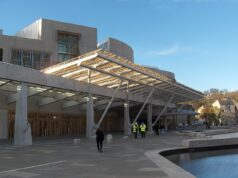
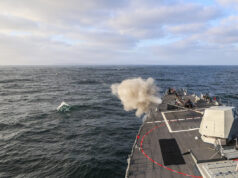
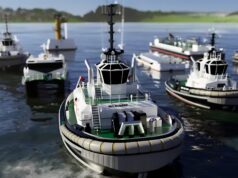
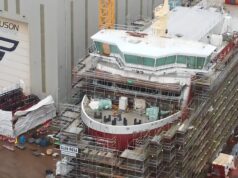
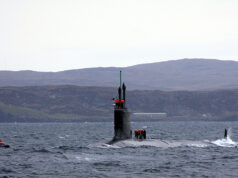
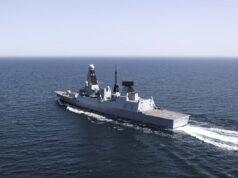
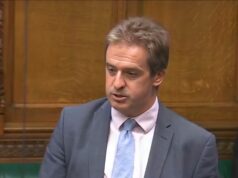
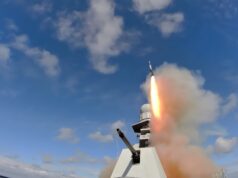
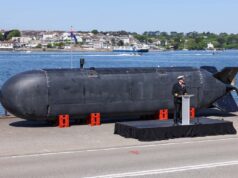
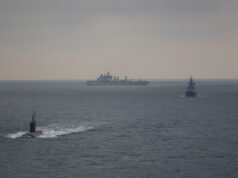

Looks like a good time in NAVSTA Mayport tonight (hopefully NOT the HMS Vigilant kind…)!
Cheers!
(Chris H) You only get to make one ‘first impression’ but I think both ship and crew nailed it …
Especially those tropicals- very retro and cool. Hope the U.S. Army follows through and brings back the Pink and Greens as expected.
Cheers!
They can moor here right next to the runway, very handy!
https://upload.wikimedia.org/wikipedia/commons/1/14/Aerial_NS_Mayport_with_CV-60_and_CV-64_1993.JPEG
Perfect, by coincidence I’m just about to fly down to Jacksonville from NY, perhaps I’ll see her as I pass over st John’s River – if not in NY harbour later in the Autumn (Fall)
Do yourself a favor and try Singleton’s in Mayport if you have a chance…
https://roadfood.com/restaurants/singletons-seafood-shack/
Old time Florida with darn good seafood and cold beer!
Cheers!
https://www.yelp.com/biz/singletons-seafood-shack-jacksonville-2
Thanks Helions, will try to visit next time when I have more time. Never saw QE but did go past Mayport. It’s a regularish trip for me so should make the effort.
no such thing in america as a decent beer, their bars are a joke.
I did actually find a really decent small bar just outside Boston that served beer from a local micro brewer, ’twas really nice so I stopped for lunch and Knocked back 10 of the funny not quite pint glasses you you get in the states in short order before ordering lunch. The barman and local guys were a bit amazed and clearly not used to your average working class British male ability to knock back the pints and still function.
The US is leading the way of craft beers. Don’t knock the IPA’s coming out of that country.
https://www.navy.mil/management/photodb/photos/180905-N-RL695-0032.JPG
Looking good!
https://www.navy.mil/management/photodb/photos/180905-N-RL695-0012.JPG
Mayport is trying to get the USN to station a carrier there after losing the JFK. Problem is, it doesn’t have a nuke capable pier. Perhaps the RN is up for a summer home for the QE’s?
Cheers!
no such thing in america as a decent beer, their bars are a joke.
https://www.navy.mil/management/photodb/photos/180905-N-DA434-050.JPG
Soon!
These F35’s belong to VMFA 211 operating off USS Essex in the Gulf of Aden. Won’t be long till the same can be attributed to the RN.
https://www.navy.mil/management/photodb/photos/180905-N-DA434-050.JPG
Sorry! Tech blip.
https://www.navy.mil/management/photodb/photos/180904-N-AT135-0011.JPG
https://www.navy.mil/management/photodb/photos/180902-N-NB142-0572.JPG
Here’s to a safe first launch. Been a long time.
Cheers
Thanks Helions
Always good to have your contributions (good or bad)
Actually it may not be a bad idea to base one of our carriers in the US for part of the year and maybe Australia for the other half
That way we fully use both (with one always based in the UK/MED – whilst the other is away) and increase our relationships in the post Brexit world.
We wouldn’t be able to sustain any sort of effective maintenance schedule with both carriers deployed that far from home. All the spares would still need to be flown or shipped in from the UK, depriving work from UK yards and increasing costs, and with only 2 carriers the UK based one would always be in refit or working up while the other was abroad with all of the Lightnings. Unfortunately, to do as you describe would require the RN moving from a rank 2 to a rank 1 navy, which would require the fleet roughly doubles in size
rank 2 navy what’s that then?
not going to happen
if we won’t operate 2 carriers why build them in the first place?
We have 2 not so we can deploy two but so we can always deploy one, although the rule of three suggests that we really need one more for the guarantee.
Gee Pacman – thanks! (I think)…
😀
Paceman- I would agree to your suggestion as it would support defence diplomacy and flying the flag but we would probably need 3 QE carriers (easily affordable with a small uptick in defence expenditure) as well as adequate surface warship numbers to support 3 carrier groups and current RN tasking.
If the RN can get back up to 26 or more surface warships (destroyers or frigates) then I would support the QE class doing the flagship role.
The UK is still a wealthy and powerful country, we could easily afford to support a much larger Royal Navy (3 carriers, 26+ destroyers and frigates, 3-4 more astute class, replacement for Ocean in LPHA role) it is just our political class that restrict the armed forces potential and decide to send £14 billion a year abroad in foreign aid. If we halved the foreign aid budget we would still be one of the most generous countries in the world.
Matching France would be more suitable after Brexit and allocating the rest to Helicopters & new carriers to replace HMS Ocean, Multi purpose Type 23e’s, Royal engineers, Transport. You get the picture.
More than justifiable in my opinion.
https://fullfact.org/economy/uk-spending-foreign-aid/?gclid=CjwKCAjwoMPcBRAWEiwAiAqZh27w6Vky213bOmmOI9zYtoGRiiSqjVnUb90_29nsGqavOG2td-mebxoCkgIQAvD_BwE
We already outweigh the Marine Nationals in most regards; our first rate warships and submarines are all bigger, more modern, and in slightly greater numbers, we have 2 bigger carriers to their one, which will be equipped with 5th gen aircraft compared to their 4.5 gen.
There are areas where the RN doesn’t compare as favourably of course: despite having more waters to patrol, we have fewer patrol craft, we only have 2 LPDs versus their 3 bigger LPAs, and their carrier is CATOBAR with the option of deploying heavier or different varieties of aircraft to the QECs. Overall though, the RN is in solid shape compared to the rest of Europe.
And don’t forget our RFA resupply capabilities which in overall tonnage and ship numbers already dwarf those of the MN and should expand even further as the new FSS ships get built and come into service (providing the new FSSs don’t result in excessive retirement of existing RFA vessels).
Don’t forget we have the 2 Albion Class and 3 Bay Class.
That dwarves the capability of the MN with their 3 Mistrals.
Add in the Argus and the capability that the Tydes and Forts bring in terms of helicopter and stores carrying and the MN is left in the dust.
The MN can’t sustain a force at distance or sustain a landing force on shore.
What you are talking about is a huge expansion of the RN. Desirable yes but extremely unlikely. 2 carriers is more than sufficient for our needs, we need to fill out the escort and sub numbers. We don’t have the crews – manpower would need to increase by 50% as well as up-arming current ships. Imagine the number of F35s we’d need – won’t happen
We never operated the Invincibles at the same tempo as the US does their carriers. And though we had 3 of them really we only ever operated 2, at even lower tempo than escorts. Of course perhaps the reason why they weren’t worth operating at a higher tempo after the Cold War was they were too small to do anything useful. I think the reverse will be true for QEC, too big to operate at a high tempo in peace, but their size will bring better value to both ourselves (and the USN and USMC) for training and any low intensity ops (the latter really is just more training really) for the next ‘Big One’. You only have to look at the French and Italian and how they use their carriers. To operate at the same tempo as the USN would mean a huge increase in the navy. For example it wouldn’t be worth doing without a full air group (say 24 F35b at least probably 36 for CAP and strike packages) , we would need to increase the buy of supporting systems like Crowsnest, we would need more rotary craft, double the number of Tides and more solid stores ships, we would have to double the number of T26, do something about SeaViper, and on and on. And we would be looking at a large increase in RN and RFA personnel too. And then there would be other costs like harbour movements and all the other hidden things along away from the exciting end of the business. (The RN ever keen to reduce the harbour movements but never fits thrusters because of costs……….) If we need them QEC will be really useful in a real war, but they are a contingency; for them to be useful we need them to be in use, not just worked up by FOST. Hard to see them generating value in peace beyond the fact that large ships have value. But costs are all swings and roundabouts. And costs and expense and value aren’t interchangeable terms.
3 carriers?!!! we’re already saying one of ours will be in dock at a time the nimitz class carrier j.f.k is on DONATION HOLD! BUY THAT, FINANCE IT BY SELLING P.O.W TO THE FRENCH TO REPLACE CHARLES DE GAULLE. THEN WE’D HAVE A NUCLEAR CARRIER FITTED WITH CATAPULTS and defensive systems. we could then lease a squadron of f 18 super hornets from the arizona regeneration facility AMARG.(google amarg inventory) and see where the u.k should be shopping look at the naval inactive ship register an see where we could have got our carriers from.
JFK is not Nuclear. She was a upgraded/last flight Kitty Hawk. The last conventionally powered Carriers procured before the Nimitz class.
We don’t want the Charles De Gaulle.
We will have better availability than the French have ever had simply by having 2 hulls. And as I said above these will be operated at a nice gentle pace where we will be able to maintain the skills base. For us the carrier is a support asset, an enabler. The USN CBG are operated at high tempo; their carriers are the tip of the spear and they are to be supported. It is a subtle difference. One due to my pain killers I am failing to explain. :9
Why would we replay our brand new state of the art carrier with a geriatric warn out relic.
How magnificent they look! A real credit to the UK! We need to get more black people in the Navy and the armed forces in general. We have enough women- please don’t get over excited on that comment – now we need to address the ethnic issue. Let’s work harder on this please.
By the way was the QE have the hand brake on getting over there?
^ spot ‘Bill’, the very obvious Russian troll.
[…] No official date has been given for the first F-35B landing on the ship, but it is expected in late September, the UK Defence Journal wrote on Wednesday. […]
[…] No official date has been given for the first F-35B landing on the ship, but it is expected in late September, the UK Defence Journal wrote on Wednesday. […]
[…] No official date has been given for the first F-35B landing on the ship, but it is expected in late September, the UK Defence Journal wrote on Wednesday. […]
[…] No official date has been given for the first F-35B landing on the ship, but it is expected in late September, the UK Defence Journal wrote on Wednesday. […]
[…] No official date has been given for the first F-35B landing on the ship, but it is expected in late September, the UK Defence Journal wrote on Wednesday. […]
[…] No official date has been given for the first F-35B landing on the ship, but it is expected in late September, the UK Defence Journal wrote on Wednesday. […]
[…] No official date has been given for the first F-35B landing on the ship, but it is expected in late September, the UK Defence Journal wrote on Wednesday. […]
[…] No official date has been given for the first F-35B landing on the ship, but it is expected in late September, the UK Defence Journal wrote on Wednesday. […]
[…] No official date has been given for the first F-35B landing on the ship, but it is expected in late September, the UK Defence Journal wrote on Wednesday. […]
[…] No official date has been given for the first F-35B landing on the ship, but it is expected in late September, the UK Defence Journal wrote on Wednesday. […]
[…] No official date has been given for the first F-35B landing on the ship, but it is expected in late September, the UK Defence Journal wrote on Wednesday. […]
[…] No official date has been given for the first F-35B landing on the ship, but it is expected in late September, the UK Defence Journal wrote on Wednesday. […]
[…] No official date has been given for the first F-35B landing on the ship, but it is expected in late September, the UK Defence Journal wrote on Wednesday. […]
[…] No official date has been given for the first F-35B landing on the ship, but it is expected in late September, the UK Defence Journal wrote on Wednesday. […]
[…] No official date has been given for the first F-35B landing on the ship, but it is expected in late September, the UK Defence Journal wrote on Wednesday. […]
[…] No official date has been given for the first F-35B landing on the ship, but it is expected in late September, the UK Defence Journal wrote on Wednesday. […]